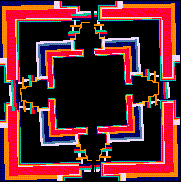
 |
The Prajnaparamita sutra invites us into the great, cosmic void, not as guests, but as rightful occupants. So far so good. But, as Buddhists talked about a "great cosmic void," they embroidered the idea and produced a multiplication of names, many names. Suddenly, the void itself started subdividing and branching and particularizing, until what was once an elegant simplicity devolved into a labyrinth of complexity. Sometime between 150 and 250 CE, a figure in Southern India named Nagarjuna swept most of this labyrinth aside and restored the immediate experience of emptiness. |
| Nagarjuna, in effect, obliterated
the rhetorical tangle of multitudinous voids and focused instead on the
simple relationship between the observer and the observed, between the
subjective self and the objective self. He recorded these observations
in a collection of thoroughly modern stanzas known as Madhyamika,
or "Doctrine of the Middle Way." Madhyamika, essentially a theory
of relativity, maintains that both subject and object are unreal. Reality
is shunyata, or "cosmic emptiness." Nothing in the Universe ever
comes and goes. Since everything is emptiness, what we perceive of the
universe is beyond positional time or space. The full Madhyamika
argument is quite difficult to explain completely and I cannot fully explain
it without substantial Nirvanic inspiration of my own. However,
the following poetic lines may approximate the essentials:
I wonder where this pleasant sensation is coming from, my cheek or my shoulder? When I press my cheek to your cheek with love, where does this same sensation come from? From me? Or from you? Or from love itself between us? Infinity divided by zero multiplied by love equals what? You and I may be able to grapple with such a poetic thought, but it would be meaningless to even the most powerful computer on earth. Since the time of Shakyamuni and, later with Nagarjuna, innumerable commentaries have been written on "non-self," "emptiness" and "Madhyamika." This vast collection of thought, Buddhist history really, provides us moderns with a kind of time machine. It's wonderful, interesting, and useful. However, life itself can proceed rather well without all these layered accretions. This is true not only of Buddhism but of other traditions as well. |